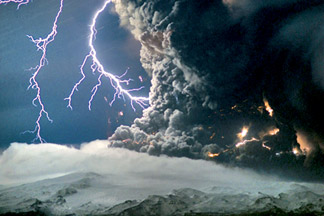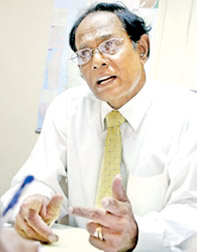|
Facing the challenge of lightning related incidents:
National Centre for Lightning Safety in the offing
By Ranil WIJAYAPALA
 The danger of lightning once again came to light last week when three
people from the same family became lightning victims incident in
Amithirigala Avissawella and another death at Baduraliya, Mathugama,
making Sri Lanka becoming one of the worst hit by lightning incidents. The danger of lightning once again came to light last week when three
people from the same family became lightning victims incident in
Amithirigala Avissawella and another death at Baduraliya, Mathugama,
making Sri Lanka becoming one of the worst hit by lightning incidents.
According to the Meteorological Department the number of deaths due
to lightning incidents reached 51 in the year 2011 giving alarming
signals about the situation and bringing the average number of deaths
due to lightning incidents in Sri Lanka from 30 to 40 per year. In the
year 1997, the number of deaths reported was 49 while 16 deaths of
animals were also reported in that year.
This shows how this natural phenomenon has badly affected the the
country despite continuous educational programs carried out by the
relevant authorities including Meteorological Department and the
Disaster Management Ministry to mitigate the damages caused by this
natural phenomenon.
However, this natural phenomenon has become a frequent killer across
the globe and according to the National Weather Service of the United
States, lightning causes an average of 62 deaths and 300 injuries in the
United States each year as it has become the number 2 Weather Killer in
the U.S.
|

G. B. Samarasinghe |
Therefore, Sri Lanka as a small island with only 65,000 square
kilometres land stretch and with 2 million population, the average of 30
to 40 lightning related deaths is an alarming level.
Apart from this the economic losses due to this natural phenomenon
has not been properly estimated as many of these incidents are not
reported properly for any evaluation by relevant authorities.
According to G. B. Samarasinghe who retired as the Chief of
Meteorology Department on March 23, the number of deaths and injuries
due to lightning strikes may be much higher than the statistics gathered
by the Met Department as many of these incidents are unreported.
He says lightning is a natural phenomenon and a disaster that cannot
be stopped by any.
"What we always can do is to just record it. You can't confront it
but can minimise the damages from it by taking precautionary action.
Other than that, there is nothing available with us to fight the
nature", he says sharing his ideas about the lightning related incidents
in Sri Lanka in an interview with the Sunday Observer just after his
retirement.
As far as lightning is concerned, it is a very natural phenomenon and
when there is enough moisture and enough heating and the atmosphere is
very unstable, clouds develop and extend to 30,000 feet and even 40,000
feet high.
Inside those clouds there are water droplets going up and down and
with their movements within the cloud an electrical charge is formed and
the minus charges you find at the bottom of the cloud and on the top you
find positive charges.
Due to these charges there may be intra-cloud flashes and inter cloud
flashes due to electrical discharges associated with the charged
cumulonimbus clouds. "But the ground stroke is the worst and the most
dangerous thing", explaining the way the lightning incidents occur,
Samarasinghe added.
The ground flash, which is important as a hazardous event, is the
electrical discharge between the negative charge centre of a cloud and
the positive charge centre on the ground. Under certain conditions,
positive ground flashes may occur between the positive charge centre of
a cloud and the earth. "This discharge is the most dangerous in this
natural phenomenon and that is what we have to avoid. The voltage
difference between these is about 100 million volts. Just think about a
25 volt battery and take a wire and take it very close you find sparks
flashing. Like that this flash comes down through the atmosphere. The
atmosphere resistance is overcome by this very high energy so that we
will have to be very careful to avoid it", he said.
"Nobody knows where it discharges. Sometimes may be there is an
affinity. When these clouds come there should be some attractive things
like metals for them to discharge this very high energy", he added.
According to Samarasinghe, in Sri Lanka the frequency of lightning
incidents are very high during inter monsoon periods between the two
main Monsoon periods the South West monsoon period from May to September
and North East Monsoon from December to February.
"Therefore, the lightning strike may occur during the first Inter
Monsoon period of the year from March to April and the second Inter
Monsoon Period from October to November ", he added.
During these Inter Monsoon periods there is no strong winds and when
there is no strong wind very tall clouds develop. Those clouds get
higher and higher and potential is very high for lightning. " That is
one reason for Inter Monsoon periods are more conducive for lightning
activities", he added.
Apart from these periods we get thunder storms during other wind
regimes like the South West monsoon and the North West monsoon when
there are disturbances like cyclones depressions, low pressure areas.
"During the North West Monsoon we get disturbances from the Bay of
Bengal and even with that we get thundery activities. But it is for a
very short period", he said.
Samarasinghe says that the latest report by the Inter Governmental
Panel for Climate Change has mentioned that convective activities are on
the increase and also creasing lightning activities are on the increase
due to climate change. "Climatic changing we are not sure this change is
for ever or it is a transition period. Sometimes when things happen, I
always say that this might be something a transition period", he added.
Samarasinghe also says that in Sri Lanka, the Met Department has
identified, Horana, Ratnapura and Avissawella areas where we get large
number of lightning incidents.
"One reason is that there is more rain in these areas. Rain is due to
the cloud development and cloud is again with the inter monsoon and
convective type of rain lightning is essentially with them", he added.
Apart from this, pockets like Kegalle, Medirigiriya, Polonnaruwa and
sometimes Hambantota have also reported lightning incidents.
You still get the lightning incidents from places like Polonnaruwa.
Sometimes in Medirigiriya, sometimes in Hambantota.
Referring to the allegations that the increased development
activities and the increase number of Telecom towers and the high rise
building also become a factor for the increase in occurrences of
lightning, Samarasinghe said that, they are inviting factors for
lightning.
"But when these high rise objects are there, we should take
precautionary action by having very good earthing systems and they have
to be checked on a regular basis, whether these earthing systems are in
order", he added
"What happens is, we do establish a proper earthing system and we
forget it. It is the case. We should check it monthly, once in three
months or by annually to check whether there is any resistivity. If
there is no resistivity it grounds smoothly.
That is the problem. When it is not grounded properly it goes around.
It goes to other directions", he added.
"I personally believe that these communication towers should be away
from the habitats", he added.
According to Samarasinghe, in the near future the Telecommunication
Regulatory Commission is also considering to have fibre optic mechanisms
where you don't need high rise towers. They don't need towers and
repeaters and even the house top can accommodate that tower. That is one
technology we need. Some telecommunication system providers in Sri Lanka
are already having this system.
But the way, since the lightning related incidents are getting
increased there should be systems to mitigate those damages.
"Last year we had 51 deaths relating to lightning. In year 2002 we
had 49 cases. We can say an average of 30 to 40 deaths per year. So this
is a problem that we have to address very soon", he added.
Nobody complains about the equipment damage. Dr. Chandana Jayaratne
and his students through a survey has estimated that lightning related
incidents cause Rs.300 million to Rs.1 billion damages to properties.
That means there is a burning problem and that is a national issue", he
added.
That is why in February 2011, Disaster Management Minister appointed
a committee with the Chairmanship of the Director General of Meteorology
to look into this situation. "At that time we started the process, and
we got all the key personnel in the country, the experts in the subject,
professors from the Moratuwa University. Dr. Chandana Jayaratna,
Telecommunication Regulatory Commission, representatives from the health
sector and all other sectors relevant to the subject", he added.
"We were just contemplating an idea when we are giving an electricity
connection the CEB should think of making it compulsory to have
lightning protection system. There are search protectors and search
diverts that has to be a part of the total package once the electricity
supply is given, may be government affording a part of the cost", he
added.
The committee has recommended to establish a National Centre for
Lightning Safety and the Cabinet paper in this regard has already been
formulated to establish a regulatory mechanism for lightning related
incidents and to have a proper data base to record all lightening
related incidents enabling the country to face this challenge
effectively and mitigate damages. |

